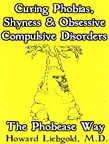

Simple or specific phobias have been quite effectively treated with behavior therapy (Marks, 1987). The behaviorists involved in classical conditioning techniques believe that the response of phobic fear is a reflex acquired to non-dangerous stimuli. The normal fear to a dangerous stimulus, such as a poisonous snake, has unfortunately been generalized over to non-poisonous ones as well. If the person were to be exposed to the non-dangerous stimulus time after time without any harm being experienced, the phobic response would gradually extinguish itself. Also, this assumes that the person does not also experience the dangerous stimulus during that same extended period of time. In other words, one would have to come across ONLY non-poisonous snakes for a prolonged period of time for such extinction to occur. This is not likely to occur naturally, so behavior therapy sets up phobic treatment involving exposure to the phobic stimulus in a safe and controlled setting. Foa and Kozak (1986) call this exposure treatment, so called because the patient is exposed to the phobic stimulus as part of the therapeutic process. One simple form of exposure treatment is that of flooding, where the person is immersed in the fear reflex until the fear itself fades away. Some phobic reactions are so strong that flooding must be done through one's imagining the phobic stimulus, rather than engaging the phobic stimulus itself.
Some patients cannot handle flooding in any form, so an alternative classical conditioning technique is used called counter-conditioning (Watson, 1924). In this form, one is trained to substitute a relaxation response for the fear response in the presence of the phobic stimulus. Relaxation is incompatible with feeling fearful or having anxiety, so it is said that the relaxation response counters the fear response. This counter-conditioning is most often used in a systematic way to very gradually introduce the feared stimulus in a step-by-step fashion known as systematic desensitization, first used by Joseph Wolpe (1958). This desensitization involves three steps: (1) training the patient to physically relax, (2) establishing an anxiety hierarchy of the stimuli involved, and (3) counter-conditioning relaxation as a response to each feared stimulus beginning first with the least anxiety-provoking stimulus and moving then to the next least anxiety-provoking stimulus until all of the items listed in the anxiety hierarchy have been dealt with successfully.
Biofeedback instrumentation has often been used to ensure that the patient is truly well-relaxed before going the next higher item in the anxiety hierarchy. Several indexes have been used in this adjunctive approach, including pulse rate, respiration rate, and electrodermal responses.
Also, systematic desensitization can be paired with modeling, an application suggested by social learning theorists. In modeling, the patient observes others (the "models") in the presence of the phobic stimulus who are responding with relaxation rather than fear. In this way, the patient is encouraged to imitate the model(s) and thereby relieve their phobia. Combining live modeling with personal imitation is sometimes called participant modeling (Bernstein, 1997).
Rothbaum et. al. (1995) reports using a virtual-reality helmet being worn by the patient which then displays a phobic situation which is controlled and monitored by the therapist. The scene might be one of driving a car over a high bridge, while pulse rate is being monitored by the therapist. When the pulse rate gets too high, the scene is either shut down or frozen in frame to allow the therapist to counter-condition relaxation to replace the fear and anxiety response.
Systematic desensitization in a variety of forms has been commonly used to treat specific phobias and, in some cases, can be achieved in a single therapeutic session (Ost, 1989; Zinbarg & others, 1992).
Foa, E. B, & Kozak, M.J. (1986). Emotional processing of fear; Exposure to corrective information. Psychological Bulletin, 99, 20-35.
Bernstein, D. A., Clarke-Stewart, A., Roy, E. J., & Wickens, C. D. (1997). Psychology, 4th ed. New York: Houghton Mifflin.
Marks, I. M. (1987). Fears, phobias, and rituals: Panic, anxiety, and their disorders. New York: Oxford University Press.
Ost, L. G. (1989). One-session treatment for specific phobias. Behavioral Research and Therapy, 27, 1-7. In Gray, P. (1994). Psychology, 2nd. ed. New York: Worth.
Rothbaum, B. O., Hodges, L.F., Kooper, R., Opdyke, D., Williford, J.S., & North, M. (1995). Effectiveness of computer-generated (virtual reality) graded exposure in the treatment of acrophobia. American Journal of Psychiatry, 152, 626-628.
Watson, J. B. (1924). Behaviorism. Chicago: University of Chicago Press.
Wolpe, J. (1958). Psychotherapy by reciprocal inhibition. Stanford: Stanford University Press.
Zinbarg, R. E., Barlow, D. H., Brown, T. A., & Hertz, R. M. (1992). Cognitive-behavioral approaches to the nature and treatment of anxiety disorders. Annual Review of Psychology, 43, 235-267. In Gray, P. (1994). Psychology, 2nd ed. New York: Worth.
